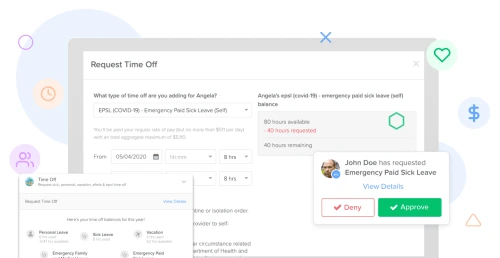5 Tips for Handling Difficult Conversations on Zoom (Or Any Video Call)
Tips for HR pros on how to handle difficult conversations, like coronavirus layoffs or furloughs, through video calls
April 7th, 2020
Remote work is ramping up, and not just in the face of COVID-19. Before the pandemic, experts predicted that at least half of the U.S. workforce would be working remotely in some capacity by 2020. FlexJobs puts that number closer to 4.7 million, or about 3.4% of the U.S. population.
And as the coronavirus pandemic continues to shutter businesses and send employees home to telework, it's becoming more evident that the flexibility to work from home is a growing necessity, not just a luxury.
The move to a remote workforce is creating no shortage of challenges for HR managers, especially when it comes to handling difficult conversations, like coronavirus layoffs, without the benefit of being face to face. Here's a popular question on HR forums and discussion groups:
How do you handle firings, layoffs, performance reviews, changes in policy, or performance warnings from afar?
When a face-to-face conversation is not possible, the next best option is to drum up a video call, so that eye contact and real-time dialogue are present, but this, too, has its considerations.
For starters, video conversations are rarely private. Employees working from home may be sharing their space with a spouse, children, or other guests who will be privy to the discussion. Also, it can feel impersonal to deliver important news via video chat, even though it's a more palatable option than email or a phone call.
Having difficult conversations with employees is never easy. If you're using Zoom or other video call software to deliver a message, here are our top 5 tips on how you can make the call professional and impactful to produce an optimal outcome.
1. Treat It Like an In-Person Meeting
Meeting with an employee via video chat isn't unlike having them in your office. The most important element is there—two-way communication. You should always deliver news or start the conversation in a way that allows the other person to participate and to ensure understanding and acceptance.
Just as you would with an in-person meeting, you should prepare any required paperwork ahead of time and have it ready to send by mail, through your HRIS, or by email for an e-signature. This may include termination acknowledgments, furlough notices, details on severance pay and benefits, or copies of policy changes or performance reviews.
2. Consider the Place and Time
If you're working with employees across time zones, consider the time you schedule the call. No one wants to start an early workday with an awkward interaction — especially right now when so many people are subject to coronavirus layoffs or furloughs.
Likewise, don't leave these difficult conversations for Friday at the end of the day. Prepare enough time to answer follow-up questions during the call, and try to make sure neither you nor the employee, end the workweek with a negative interaction. Mental health wellness must be a priority for both parties.
If you need to have an important conversation with an entire team, it's usually best to do it all at once rather than individually. In essence, this helps prevent the spread of rumors and controls the release of information.
Also, consider where the employee may be when you're having the conversation. They may be distracted if having to work from a coffee shop or other non-private area and may not get the full benefit of your message.
3. Engage a Witness
As with many in-person HR meetings, it's wise to get another leader on board to witness the conversation. On a video call, you should make it known that someone else is joining you, so there's no question about the events that are taking place. Having a witness can be beneficial to both HR and the employee, as it encourages transparency in the interaction.
4. Encourage Two-Way Communication
Most employees will have questions about your message, which is why email and text are never ideal channels for delivering essential news. And if they don't have immediate concerns, they might once you sign off, and the gravity of your message sinks in.
Encourage them to reach out, now and in the future, if they have questions on how to move forward. If it's something that impacts an entire team, schedule a follow-up Q&A session to address unique needs.
5. Be Aware of the Humanity Behind the Screen
The distance created by technology has a way of disconnecting us from the human element of our interactions, even when we can see the person on the other side of the screen. Whether you're talking about a recent performance review, a salary increase, or a potential cut in hours, it's important to remember that you're still dealing with real people with real emotions. They may have families who may be listening to the video call in the background. It's essential to remain professional and empathetic when presenting news, especially if it's news that no one wants to hear.
The best approach you can take when establishing a remote layoff process or having difficult conversations over video calls with employees is being honest, listening attentively, and offering solutions. Difficult conversations with employees don't disappear when working remotely, but the way you handle these interactions will ultimately reflect on you and the company.
Recommended Posts
Recommended Posts
The Complete Employee Offboarding Process [+ Checklist]
Blog Articles
Search...
Product
GoCo
Resources
Articles
eBooks
Webinars
Customer Stories





